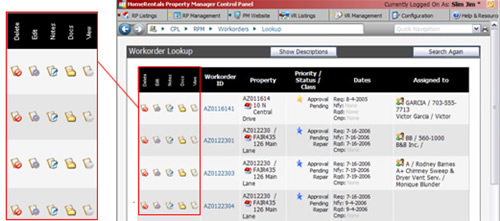 Figure 46 |
Delete: You should only delete a workorder when it has been entered in error. If the workorder is complete, simply edit it and enter the “Completed” date. If you have enabled "Complete on Edit" in System Preferences, workorders will be marked as completed the first time you edit and save changes.
Edit: You may edit a workorder to adjust its status, priority, or other criteria. After you modify a workorder, you are able to email the updated version to the vendor if you mark the “Email Workorder to Vendor” checkbox before you save it. When the vendor has completed the workorder task, make sure you edit the workorder and enter the completion date and time. Whenever you make a change in a workorder, click “Save Workorder” to save the changes.
If you have enabled "Complete on Edit" in System Preferences, workorders will be marked as completed the first time you edit and save changes. If Complete on Edit is enabled and you need to make a change to a workorder that is not completed, make sure you clear the "Date Completed" before you save the change.
Notes: The “Notes” option allows you to document internal notes with the workorder. The notes in the workorder “Description” field are visible to the vendor. The internal notes you enter into these system notes field can only be viewed by your staff.
| 1. | History: The workorder history notes are a permanent record of the system changes and notes added manually to the workorder. The history notes cannot be edited. |
| 2. | Quick Notes: Quick Notes are front and center notes. These notes are not permanently recorded in the History notes and can be edited. |
| 3. | Notes: Use Notes to add non-system generated comments to the permanent workorder history. The Notes can also be added to Quick Notes so that they are readily accessible without searching the notes history. |
Docs: You may attach vendor documents to a workorder. The documents might include detailed instructions about the work needed, the associated invoice, or photos of damage.
View: The “View” option allows you to view and print a workorder so you can hand it, mail it, or fax it to a vendor. The printed version of the workorder is the same as the emailed version. Many property managers ask their vendors to return the printed workorder with their invoice so they can easily correlate the work performed to the original workorder.
The colors of the star Priority Indicator icons help you quickly identify those workorders that require immediate attention.
| 1. | Yellow: Low |
| 2. | Blue: Normal |
| 3. | Purple: High |
| 4. | Red: Emergency |